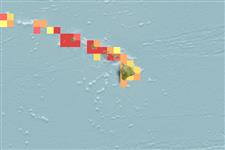>
Clupeiformes (Herrings) >
Engraulidae (Anchovies) > Engraulinae
Etymology: Encrasicholina: Greek, egkrasicholos, -os, -on = mixed with spleen.
More on author: Fowler.
Environment: milieu / climate zone / depth range / distribution range
Ecologia
marinhas; estuarina; intervalo de profundidade 0 - 50 m (Ref. 189). Tropical; 25°N - 14°N, 165°W - 143°W (Ref. 189)
Eastern Central Pacific: endemic to Hawaii, but its use as a baitfish may spread its range.
Tamanho / Peso / Idade
Maturity: Lm ? range ? - ? cm
Max length : 7.5 cm SL macho/indeterminado; (Ref. 189)
Espinhos dorsais (total) : 0; Espinhos anais: 0; Raios anais moles: 13 - 15. Most specimens without pre-pelvic scutes, but some with 1 to 5 thin needle-like scutes. Maxilla tip blunt, reaching to front border of pre-operculum, but scarcely projecting beyond second supra-maxilla. Isthmus short, preceded by a small fleshy plate on urohyal between branchial membranes. Anal fin short, its origin behind base of last dorsal fin ray.
Epipelagic (Ref. 58302). A schooling species living close inshore and entering bays, inlets, estuaries, canals and even penetrating into fish ponds, thus able to tolerate a wide range of salinities. Feeds mainly on planktonic crustacean larvae. Breeds throughout the year, with a peak in summer, spawning at night (between 2200 and 0200 hours) in bays and estuaries (Ref. 189).
Life cycle and mating behavior
Maturidade | Reprodução | Desova | Ovos | Fecundidade | Larvas
Spawn in bays and estuaries in school (Ref. 205). Spawning is said to be continuous throughout the season (Ref. 32412, 40290).
Whitehead, P.J.P., G.J. Nelson and T. Wongratana, 1988. FAO Species Catalogue. Vol. 7. Clupeoid fishes of the world (Suborder Clupeoidei). An annotated and illustrated catalogue of the herrings, sardines, pilchards, sprats, shads, anchovies and wolf-herrings. FAO Fish. Synop. 125(7/2):305-579. Rome: FAO. (Ref. 189)
Categoria na Lista Vermelha da IUCN (Ref. 130435: Version 2024-1)
Ameaça para o homem
Harmless
Utilização humana
Pescarias: pouco comercial; isco: usually
Ferramentas
Relatórios especiais
Descarregue XML
Fontes da internet
Estimates based on models
Preferred temperature (Ref.
123201): 25 - 25.6, mean 25.3 °C (based on 32 cells).
Phylogenetic diversity index (Ref.
82804): PD
50 = 0.5039 [Uniqueness, from 0.5 = low to 2.0 = high].
Bayesian length-weight: a=0.00955 (0.00529 - 0.01725), b=3.20 (3.04 - 3.36), in cm total length, based on LWR estimates for this species & (Sub)family-body (Ref.
93245).
Nível Trófico (Ref.
69278): 3.1 ±0.30 se; based on food items.
Resiliência (Ref.
120179): Elevada, tempo mínimo de duplicação da população menor que 15 meses (K=1.7).
Fishing Vulnerability (Ref.
59153): Low vulnerability (10 of 100).
